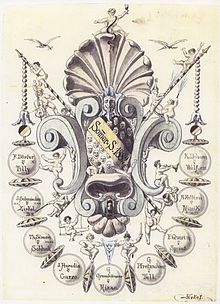K.St.V. Laetitia Karlsruhe
| Circle | |
|---|---|
| Basic data | |
| Founding: | November 27, 1866 |
| Place of foundation: | Karlsruhe |
| Association: | KV |
| Entry into the KV: | 3rd General Assembly of KV 1869 |
| Abbreviation: | Lt! |
| Colours: | Black-gold-white |
| Tape: | without |
| Cap: | without |
| Motto: | In serenis laetitia, in adversis constantia, in omnibus fiducia! |
| Club magazine: | Laetite leaves |
| Members: | approx. 200 old men |
| Status: | active |
| Support association: | Student residence Laetitia eV, Karlsruhe |
| Website dormitory: | studentenheim-laetitia.de |
| Website: | kstv-laetitia.de |
The Catholic student association Laetitia is a non- striking and non- colored , Catholic student corporation at the Karlsruhe Institute of Technology, founded in 1866 . Its principles are religio , scientia and amicitia . It is the seventh oldest association in the Cartel Association of Catholic German Student Associations (KV).
History of the club
The founding years
In 1865, two students from the Technical University in Karlsruhe , the then capital of the Grand Duchy of Baden , attempted for the first time to found a Catholic student association - similar to the one already existing at other universities (Munich, Bonn, Berlin, Breslau, Münster). However, to their disappointment, they encountered total disinterest and a strong anti-Catholic mood.
On November 27, 1866, however, it was possible to set up an association with now six founding members. This was done with the aim of “... to offer young Catholic men from the educated classes a point of unification for mutual entertainment and mutual instruction.” Initially, however, a purely student association was not considered, as can be seen from the fact that only three of the founders were studying.
In autumn 1868 correspondence with the cartel association of Catholic German student associations (KV), which had already been founded, was initiated with the aim of joining it; The 3rd General Assembly of the umbrella organization, which met in Würzburg in 1869, met this wish of the Laetites.

Laetitia became - as the first Catholic association at a technical university and as the oldest Catholic corporation in what was then the Grand Duchy of Baden - the seventh member of the cartel association, which today has 137 associations (approx. 50 dormant). Efforts are also being made in Heidelberg and Freiburg im Breisgau to set up similar corporations. In Heidelberg in 1870 people felt they were entitled to good hopes.
After an initially encouraging start, the Franco-German War in 1870/71 brought the life of ties to a standstill as the active went into the field. Therefore one initiated the dissolution of the Laetitiae and transferred the Carolingia-Aachen 1872 statutes and further association property with the condition to join the umbrella organization; Likewise, a good word was inserted for the Carolingia at the General Assembly in 1872 that it should be regarded as a continuation of the extinguishing Laetitia. Encouraged by the friends Palatia-Heidelberg, the Laetitia was re-established in 1874, as well as the approval as an association at the Polytechnic by its director and the resumption of membership in the association. By the way, up to the 33rd Foundation Festival, calculated from then on, 1874 was considered the date of foundation for numbering the Foundation Festivals. In 1880, Brisgovia was founded in Freiburg im Breisgau , in which a Laetite, Franz Isele, played a major role.

In 1891 an excluded Laetite was involved in founding today's neighbor, the KDStV Normannia im CV . The Laetitia reacted indignantly.
In the course of the following years, however, an extremely good cooperation with Normannia developed, mainly due to the hostility on the part of the fraternities and individual professors hostile to the Catholic Church.

In 1900 Pope Leo XIII became. presented an address of homage made by a Laetite with the participation of a federal brother in Rome . This greeting from the KV - it is the third one made by a Laetite after 1863 and 1867 - is transferred by the Pope to the Vatican museums , where it can still be viewed today.
In 1908 the association Laetitenhaus eV (today: Studentenheim Laetitia eV) was founded out of the desire for its own fraternity house. When several Philistines moved from Karlsruhe in 1910, the idea of founding an old men’s association (AHV) arose, which was put into practice in 1911. In 1913 Laetitia chaired the student union (a forerunner of the AStA ).
The First World War and the Weimar Republic
With the outbreak of World War I , all active volunteers registered. It was not until 1919 that corporation operations were resumed with the wedging of fifteen foxes by five boys.
In 1925, the "Gasclub" was founded in Hamborn with the significant contribution of Rudi Kunz as a branch of Laetitia in the Ruhr area, an association of Philistines Laetitiae based in the Ruhr area .
In 1928 the long-awaited first Laetitenhaus at Waldhornstraße 28 was inaugurated. The then chairman of the house building association (HBV), Franz Lenze, played a key role in realizing the idea of having one's own house. Today the Karlsruhe fraternity, Tulla, resides there opposite the mathematics building.
Third Reich and World War II
When the National Socialists came to power, the entire corporation system changed drastically: the introduction of the Führer principle could be infiltrated by the “appointment” of the senior, who was still democratically elected by the Convention, as liaison leader; but if you didn't want to be banned you had to take part in national events, formal service, service in the SA and the like.
However, the dictatorship was not expected to last for longer, which is why no more energetic resistance was offered. The KV was a member of the German student body - subordinate to the Reichsführer NSDStB - the liaison houses were now called Kameradschaftshäuser.
For example, it was courageous to hold a religious conference in 1934. To illustrate the courage of the Federal Brethren at the time, a quote from the semester report of the year: “It has been shown that it is advisable to limit the application of the Führer principle to the bare essentials and in every detail Cases to strive for an adjustment to the opinion of the convent. ”So the elimination of democratic opinion-forming aimed at by the Nazis was undermined by the convent.
In 1935 the KV - in the meantime renamed the Kartellverband Deutscher Burschenschaftlicherverbindungen - dissolved itself under pressure from politics and the Gestapo . With that the active life of Laetitiae came to an end for the time being. In 1937 the Philistines were still hoping for a political turnaround that would give way to the connection again and make the threatened sale of the house so painstakingly acquired superfluous. Despite the unfavorable political conditions, a few regulars' tables were held in different places. Under pressure from the Gestapo and after being banned from being “public hostile”, the Laetitenhaus, which had been confiscated by the Gestapo, was sold at a lower price to the carpenter who had his workshop on the first floor of the house. The low proceeds roughly covered the remaining mortgage on the house. In 1944 the former house was bombed out.
post war period
After the turmoil after the war, the difficult start of talks with the American occupation authorities began in 1947 to re-establish Laetitiae. In the winter semester 47/48 the corporation was resumed in the rooms of the Catholic University Community (KHG). Laetitia took off so that they thought about splitting the connection because of too large a membership. In 1949 the K.St.V. Zollern-Breslau reactivated by some Laetites, some of whom left Laetitia, some of whom were also B-Philistines (inactive Philistines) Laetitiae.
At the foundation festival in 1950, the HBV was re-established. In the old rulers it was clear that the construction of a new Laetite house would mean a particularly large (financial) sacrifice of the Philistines at this time . However, the acquisition of land and house construction was pursued with determination.
In 1951 Laetitia initiated a Kommers of all KV corporations in Heidelberg located in the Rhine-Main-Neckar area. Today the Kommers is known as the Heidelberger Schlosskommers and is visited by all KV connections. The first two times, Laetites also held the presidency. In 1956 the inauguration of the new house on Kornblumenstrasse, which was built on the former tennis courts of the neighboring Tuiskonia fraternity , took place.
In 1966 the 100th foundation festival was celebrated. After the difficulties in the late 1960s and early 1970s, which corresponded to the zeitgeist, Laetitia enjoyed great popularity again until the 1990s. In the summer semester of 1987, Laetitia was elected suburb at the 85th Representative Assembly (= VV) of the KV in Koblenz. In the 1990s, the connecting house underwent numerous renovations.
See also
literature
- Karl Hoeber : Handbook for the members of the Association of Catholic Student Associations in Germany. 2nd edition, Verlag Bachem, Cologne no year, pp. 145–147; 4th edition, Verlag Bachem, Cologne 1921, pp. 125–126.
- Directory of members: Yearbook of the Cartel Association of Catholic Student Associations in Germany (KV). 29th year 1931, Berlin 1931, pp. 125-127.
Individual evidence
- ^ EH Eberhard: Handbook of the student liaison system. Leipzig, 1924/25, p. 143.

